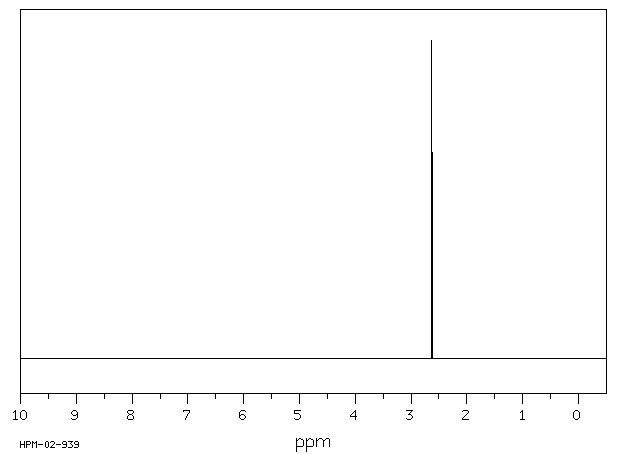二甲基二碲化物 | 20334-43-4
分子结构分类
中文名称
二甲基二碲化物
中文别名
——
英文名称
dimethyl ditelluride
英文别名
(methylditellanyl)methane
CAS
20334-43-4
化学式
C2H6Te2
mdl
——
分子量
285.27
InChiKey
LCMDQKIQBKULEI-UHFFFAOYSA-N
BEILSTEIN
——
EINECS
——
-
物化性质
-
计算性质
-
ADMET
-
安全信息
-
SDS
-
制备方法与用途
-
上下游信息
-
文献信息
-
表征谱图
-
同类化合物
-
相关功能分类
-
相关结构分类
物化性质
-
沸点:196 °C
-
密度:2.7582 g/cm3
计算性质
-
辛醇/水分配系数(LogP):0.41
-
重原子数:4
-
可旋转键数:1
-
环数:0.0
-
sp3杂化的碳原子比例:1.0
-
拓扑面积:0
-
氢给体数:0
-
氢受体数:0
安全信息
-
危险等级:4.2
-
海关编码:2931900090
-
储存条件:室温
SDS
反应信息
-
作为反应物:描述:参考文献:名称:Lewis-base behavior of methyltellurium (IV) bromides摘要:DOI:10.1021/ja01019a012
-
作为产物:参考文献:名称:Pearson; Purcell, Journal of the Chemical Society, 1935, p. 1154摘要:DOI:
-
作为试剂:描述:2,2''-anhydro-1-(3'',5''-di-O-acetyl-β-D-arabinofuranosyl)uracil 在 sodium tetrahydroborate 、 二甲基二碲化物 、 乙醇 作用下, 以 四氢呋喃 为溶剂, 以80%的产率得到5'-O-acetyl-2',3'-didehydro-2',3'-dideoxyuridine参考文献:名称:新的碲化物介导的消除反应,可合成2',3'-Didehydro-2',3'-Dideoxynucleosides摘要:几种2',3'-双脱氧核苷(ddNs)和2',3'-双脱氢-2',3'-双脱氧核苷(d4Ns)是FDA批准的抗HIV药物。通过方便地合成的2,2'-脱水核苷,我们通过发现和应用新的碲化物介导的消除反应,开发了一种新颖的d4Ns合成方法。我们的实验结果表明,在将2,2'-脱水核苷替换为碲化物单阴离子后,形成了碲化物中间体,其消除导致形成烯烃产物(d4Ns)。我们的机理研究表明,碲化物辅助反应包括两个步骤:取代(或添加)和消除。通过使用二甲基二碲化物(0.1当量)作为试剂,通过碲化物介导的消除反应,可以合成d4Ns,产率高达90%。DOI:10.1021/jo7025806
文献信息
-
Lithium halide ion-pair recognition with halogen bonding and chalcogen bonding heteroditopic macrocycles作者:Yuen Cheong Tse、Andrew Docker、Zongyao Zhang、Paul D. BeerDOI:10.1039/d1cc01287h日期:——contrasting halide anion selectivity and binding affinity, with the halogen bonding ditopic host capable of exclusively binding lithium chloride whereas the chalcogen bonding ditopic receptor displays notable selectivity for lithium iodide over lithium bromide. Preliminary solid–liquid extraction experiments demonstrate the potential of sigma–hole mediated ion-pair recognition as a promising strategy
-
One‐Step Synthesis of Dendritic Highly Branched Polystyrenes by Organotellurium‐Mediated Copolymerization of Styrene and a Dienyl Telluride Monomer作者:Yangtian Lu、Shigeru YamagoDOI:10.1002/anie.201814566日期:2019.3.18Dendritic highly branched polystyrenes (HB‐PSts) were prepared by a one‐step copolymerization of dienyl telluride 6 and St in the presence of organotellurium chain transfer agent 2. The molecular weight (MW), dendritic generation, and branching density were easily controlled by the ratio of 2 to 6 to styrene (St) with maintaining monodispersity. The branching efficiency estimated by a deuterium‐labeling
-
Synthesis of Multivalent Organotellurium Chain-Transfer Agents by Post-modification and Their Applications in Living Radical Polymerization作者:Weijia Fan、Yasuyuki Nakamura、Shigeru YamagoDOI:10.1002/chem.201603682日期:2016.11.14organotellurium chain‐transfer agents (CTAs) for living radical polymerization were synthesized by post‐modification, which involved the condensation between a carboxylic‐acid‐functionalized CTA and various amines in excellent yields without affecting the reactive tellurium moiety. The CTAs exhibited high synthetic versatility for radical polymerization and gave structurally well‐controlled polymers, such as
-
Synthesis of Concentrated Polymer Brushes via Surface-Initiated Organotellurium-Mediated Living Radical Polymerization作者:Shigeru Yamago、Yoshikazu Yahata、Kouji Nakanishi、Shota Konishi、Eiichi Kayahara、Akihiro Nomura、Atsushi Goto、Yoshinobu TsujiiDOI:10.1021/ma401385a日期:2013.9.10surface of a silicon wafer and silica nanoparticle (SiP). Surface-initiated organotellurium-mediated living radical polymerization (SI-TERP) from the immobilized CTA in the presence of nonimmobilized (free) organotellurium CTA was examined. Concentrated polymer brushes (CPBs) having surface occupancies above 0.1 were prepared by polymerization of various monomers, including styrene, methyl methacrylate轴承在一端具有三乙氧基甲硅烷基且在另一2- methyltellanyl -2-甲基基团的有机碲链转移剂(CTA),制备并固定在硅晶片和二氧化硅纳米微粒(SIP)的表面上。在未固定的(游离)有机碲CTA的存在下,对来自固定CTA的表面引发的有机碲介导的活性自由基聚合(SI-TERP)进行了研究。浓缩的聚合物刷(CPBS)以上0.1具有表面占有率是由不同的单体,包括苯乙烯,甲基丙烯酸甲酯,丙烯酸丁酯,聚合制备ñ -异丙基丙烯酰胺,ñ -乙烯基吡咯烷酮(NVP),和Ñ乙烯基咔唑(NVC)。所有CPB均以受控方式形成,其数均分子量接近理论值且低多分散指数(<1.41)。未缀合的,其包括在结构的单体良好控制CPBS,NVP和NVC,被首次制备。所述CPBS的原子力显微镜和透射电子显微镜分析显示在良溶剂中的接枝聚合物链的高度拉伸的和各向异性的结构。
-
Homolytic reactions of diorganotellurium and diorganoditellurium compounds in solution; an EPR study作者:William Bell、David J. Cole-Hamilton、Peter N. Culshaw、A.Ewan D. McQueen、D.V. Shenai-Khatkhate、John C. Walton、Janet E. HailsDOI:10.1016/0022-328x(92)80094-e日期:1992.6di-t-butyl, diallyl, allyl methyl, and dibenzyl tellurium showed EPR spectra of t-butyl, allyl, allyl, and benzyl radicals respectively. Alkyl radicals were not detected directly on thermolysis in the range 300–370 K but, primary, secondary, and tertiary alkyl, benzyl and allyl telluriums gave spin adducts of the corresponding alkyl radical with nitrosodurene. Dimethyl tellurium was unreactive in the same通过EPR光谱研究了二烷基碲和二烷基二碲在叔丁基苯溶剂中的热分解和光化学分解。光解时,二叔丁基,二烯丙基,烯丙基甲基和二苄基碲分别显示了叔丁基,烯丙基,烯丙基和苄基的EPR光谱。在300-370 K范围内,未通过热分解直接检测到烷基,但伯,仲和叔烷基,苄基和烯丙基碲使相应烷基与亚硝基磺脲发生自旋加成。二甲基碲在相同温度范围内不反应。在315 k中的二有机取代基telluriums的热分解的速率被认为是按以下顺序,由自旋加合物光谱的强度来判断:吨卜2碲〜吨BuTeMe>(烯丙基)2 Te〜烯丙基TeMe> s Bu 2 Te>(苄基)2 Te> i Pr 2 Te> Et 2 Te> Me 2 Te。对于二己基-5-烯基碲,结果与己基5-烯基和己基5-烯丙基基团的形成和环化相一致。在dipent -4- enyltellurium的情况下,结果表明,两者外型-和内戊烯telluryl自由基-
表征谱图
-
氢谱1HNMR
-
质谱MS
-
碳谱13CNMR
-
红外IR
-
拉曼Raman
-
峰位数据
-
峰位匹配
-
表征信息
同类化合物
高氯酸钪
高氯酸胍
高氯酸甲酯
高氯酸四甲基铵
高氯酸四乙基铵
高氯酸吡咯烷
高氯酸三丁基锡
高氯酸[4-(2,5-二羰基吡咯烷-1-基)丁-2-炔-1-基](二甲基)锍
高氯酸2-羟乙基酯
高氯酸2-羟丙基酯
顺式-2-硝基环己基高氯酸盐
铵钪硝酸盐(2:1:5)
铵氧代-三氧代锝
铅(2+)砷酸盐-三丁基锡烷基水合物(3:2:2:1)
钪三溴酸盐
钠O-(四氢-2-呋喃基甲基)硫代硫酸酯
重铬酸咪唑
重铬酸吡啶
过氧硝酸甲酯
过氧硝酸环戊酯
过氧化,硝基1-羰基-2-丙烯基
过氧化,甲磺酰硝基
过氧丙酰硝酸酯
膦酸二异丁基酯
磷酸组胺
磷酸(羟基-甲氧基-磷酰)二甲酯
磷酸(羟基-异戊氧基磷酰)二异戊基酯
碳化钨
碲烷
碲杂环丁烷
碲吩-2-羧酸
碲吩
硼酸异辛酯
硼酸十六烷基酯
硼酸三辛酯
硼酸三甲酯
硼酸三烯丙酯
硼酸三正己酯
硼酸三月桂酯
硼酸三异丙酯
硼酸三庚酯
硼酸三亚甲酯
硼酸三乙酯
硼酸三丙酯
硼酸三丁酯-11B
硼酸三丁酯-10B
硼酸三丁酯
硼酸三-[3-(3-甲氧基-丙氧基)-丙基]酯
硼酸三-(2-氯甲氧基-乙基)酯
硼酸三(六氟异丙基)酯







